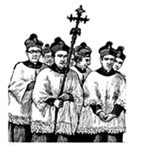
Why I Attend the Traditional Latin Mass
A HARVARD STUDENT SPEAKS OUT
Introibo ad altare Dei — “I will go unto the altar of God.” So begins the holy sacrifice of the Mass, as it has been celebrated in the Roman rite of the Church for well over a millennium. Contrary to the sincere wishes of the liturgical apparatus that has visited havoc upon orthodox Catholics for the past forty years, the traditional Latin liturgy still survives. Indeed, not only does it survive, but it is attracting new followers and exciting a profound piety in Catholics of all ages — many of whom, like myself, were born over a decade after the imposition of the new liturgy. With the recognition by many concerned Catholics that the lex orandi of the modern liturgy is not an adequate expression of the Church’s lex credendi, there has been concerted effort in recent years to address the poverty of Catholic liturgical life today. (The “reform of the reform” solution proposed by Joseph Cardinal Ratzinger and Fr. Joseph Fessio immediately comes to mind.) While many orthodox Catholics are directing their attention to salvaging the Novus Ordo Missae introduced by Pope Paul VI in 1969, many others are directing their energies toward the restoration — or at least the revival — of the traditional Latin Mass.
At the outset, I should entertain one particular question about the old Mass: What’s in a name? The traditional rite of Mass, which prevailed from the very first Christian centuries until right after the Second Vatican Council, is often called the “Latin Mass” or the “Tridentine Mass.” Neither of these two names, strictly speaking, is satisfactory. While it is certainly true that the old Mass is celebrated in Latin, the new Mass is technically also a Latin Mass — it is, after all, a Mass of the Latin rite (as opposed to the Byzantine or Maronite rites, for example) and the Missale Romanum of Paul VI was written in Latin. The Oratorian Fathers, as well as some monasteries, are known to celebrate the new Mass mostly or entirely in Latin. But, in view of the fact that the new liturgy is most often celebrated in the vulgar tongue (and the ICEL translation reminds one what a vulgar tongue it can be!), it is not surprising that no one thinks of the new Mass as the Latin Mass.
To call the old Mass the “Tridentine” Mass is also misleading. Although the Roman Mass did undergo some minor revisions and purifications under Pope St. Pius V after the Council of Trent in the 16th century (“Tridentine” comes from the Latin for Trent), it is not the case that the missal of 1570 was a new or fabricated product. Unlike the new liturgy, which was produced by a committee of liturgical “experts” almost from scratch in 1969, the missal of Pius V merely attended to “the preservation of a pure liturgy” — the same liturgy, in fact, whose core elements had been codified by the reign of Pope St. Gregory the Great in the sixth century. Reliable liturgical scholars, such as Fr. Adrian Fortescue and Msgr. Klaus Gamber, have documented the antiquity of the traditional Roman rite. The most recent edition of the traditional missal was published in 1962. This is the missal used by the priests, such as those of the Priestly Fraternity of St. Peter, authorized by the Holy See to preserve the classical liturgy. The changes made in 1962, like those made by Pius V and some of his successors, were minor and organic, leaving the integrity of the rite in place.
Catholics of all ages should be grateful to Pope John Paul II for the understanding he has shown to those Catholics who still desire the old Mass. Even if the Holy Father himself views the modern liturgical experiment as a blessing for the Church, he has nonetheless urged the bishops of the world to respect the desire of many Catholics to worship in the manner of their fathers. In his 1988 motu proprio, Ecclesia Dei, in fact, the Pope asked the bishops to grant “wide and generous” permission for the old liturgy, in order to accommodate “the feelings of all those who are attached to the Latin liturgical tradition.” (The Pope celebrated the classical Mass last summer in his private chapel at Castel Gandolfo.)
You May Also Enjoy
The history of liturgical reform that led to the promulgation of the New Mass predated Vatican II by several decades.
The Tridentine Latin Mass is extraordinary, from another source, from the outside world -- it takes one Heavenward.
The Latin Mass is an immersion in mystery and an intricate recognition of my own subordination as simple creature before simple Creator.

